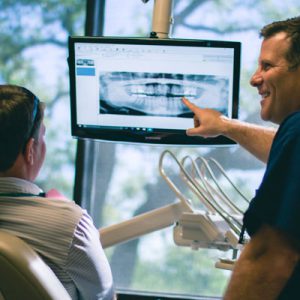Digital X-Rays
Digital radiographs (x-rays) are essential, preventative, diagnostic tools that provide valuable information not visible during a regular dental exam. We use digital radiography only in the office. Dentists and dental hygienists use this information to safely and accurately detect hidden dental abnormalities and complete an accurate treatment plan. Without digital x-rays, problem areas may go undetected.
Digital X-Rays may reveal:
- Abscesses or cysts.
- Bone loss.
- Cancerous and non-cancerous tumors.
- Decay between the teeth.
- Developmental abnormalities.
- Poor tooth and root positions.
- Problems inside a tooth or below the gum line.
- Detecting and treating dental problems at an early stage can save you time, money, unnecessary discomfort, and your teeth!
 Digital x-rays are computer generated images. These images require up to 90% less radiation than with conventional film type x-rays. Instead of using the traditional silver-oxide x-ray film that must be developed and then fixed in caustic and environmentally damaging solutions, the new system takes pictures via a small electronic sensor and it then instantaneously transmits a picture of the tooth onto the video monitor in the treatment room. Therefore, we can see your teeth and surrounding structures immediately. Not only does the new digital x-ray eliminate the usual wait for x-ray film to be processed, but it also is highly sensitive, so that patients are exposed to even less radiation than with conventional x-rays.
Digital x-rays are computer generated images. These images require up to 90% less radiation than with conventional film type x-rays. Instead of using the traditional silver-oxide x-ray film that must be developed and then fixed in caustic and environmentally damaging solutions, the new system takes pictures via a small electronic sensor and it then instantaneously transmits a picture of the tooth onto the video monitor in the treatment room. Therefore, we can see your teeth and surrounding structures immediately. Not only does the new digital x-ray eliminate the usual wait for x-ray film to be processed, but it also is highly sensitive, so that patients are exposed to even less radiation than with conventional x-rays.
How often should digital x-rays be taken?
The need for digital x-rays depends on each patient’s individual dental health needs. Your dentist and dental hygienist will recommend necessary x-rays based on the review of your medical and dental history, dental exam, signs and symptoms, age consideration, and risk for disease.
A full mouth series of digital x-rays is recommended for new patients. A full series is usually good for three to five years.